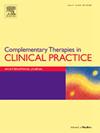Practitioner characteristics of osteopaths who treat pregnant women and children: An Australasian perspective from two practice-based research networks
IF 2.2
3区 医学
Q2 INTEGRATIVE & COMPLEMENTARY MEDICINE
引用次数: 0
Abstract
Background
Although there is evidence supporting positive outcomes for osteopathic healthcare during pregnancy and post-natal phases, there is very little that describes the practice and management characteristics of osteopaths providing this healthcare. The aim of this study is to describe the specific characteristics of Australian and New Zealand osteopaths who often treat pregnant women and children.
Material and methods
The study is a secondary analysis of data from osteopathy practice-based research networks (PBRN) in Australia and New Zealand. Chi-square tests were used to explore associations between practitioner and practice characteristics among osteopaths who report often providing care to children (aged up to 3 years, or between 4 and 18 years) and pregnant women, and those who do not. Backward logistic regression was used to identify significant predictors of Australian osteopaths who report often providing care to children (aged up to 3 years, or between 4 and 18 years) and pregnant women.
Results
One third (33.4 %) of surveyed Australian and New Zealand osteopaths (n = 1269) indicated they treat pregnant patients often, while 18.3 % indicated they often treat children up to 3 years old, and 28.7 % indicated often treating children between 4 and 18 years old. Osteopaths who treated pregnant women and children were more likely to be female and to have 15 years or more of clinical experience. Osteopaths who treated pregnant women were more likely to often treat patients up three years old, compared to osteopaths who reported not often treating pregnant women.
Conclusion
These characteristics suggest osteopaths who provide care to pregnant women are more commonly female, and female osteopaths are more likely to treat children under 3 years old.
治疗孕妇和儿童的骨科医生的从业特点:从两个以实践为基础的研究网络看澳大利亚的视角
背景虽然有证据支持孕期和产后阶段的骨科医疗保健能带来积极的效果,但对提供此类医疗保健服务的骨科医生的实践和管理特点却鲜有描述。本研究旨在描述澳大利亚和新西兰经常为孕妇和儿童提供治疗的骨科医生的具体特点。材料与方法本研究是对澳大利亚和新西兰骨科实践研究网络(PBRN)数据的二次分析。研究采用卡方检验法来探讨经常为儿童(3 岁以下或 4 至 18 岁之间)和孕妇提供治疗的骨科医生与不经常提供治疗的骨科医生之间的从业人员和执业特征之间的关联。结果三分之一(33.4%)的受访澳大利亚和新西兰骨科医生(n = 1269)表示他们经常治疗孕妇患者,18.3%表示他们经常治疗3岁以下的儿童,28.7%表示他们经常治疗4至18岁的儿童。治疗孕妇和儿童的骨科医生多为女性,并拥有 15 年或以上的临床经验。与不经常治疗孕妇的骨科医生相比,治疗孕妇的骨科医生更有可能经常治疗 3 岁以下的患者。
本文章由计算机程序翻译,如有差异,请以英文原文为准。
求助全文
约1分钟内获得全文
求助全文
来源期刊

Complementary Therapies in Clinical Practice
INTEGRATIVE & COMPLEMENTARY MEDICINE-
CiteScore
6.30
自引率
6.70%
发文量
157
审稿时长
40 days
期刊介绍:
Complementary Therapies in Clinical Practice is an internationally refereed journal published to meet the broad ranging needs of the healthcare profession in the effective and professional integration of complementary therapies within clinical practice.
Complementary Therapies in Clinical Practice aims to provide rigorous peer reviewed papers addressing research, implementation of complementary therapies (CTs) in the clinical setting, legal and ethical concerns, evaluative accounts of therapy in practice, philosophical analysis of emergent social trends in CTs, excellence in clinical judgement, best practice, problem management, therapy information, policy development and management of change in order to promote safe and efficacious clinical practice.
Complementary Therapies in Clinical Practice welcomes and considers accounts of reflective practice.
 求助内容:
求助内容: 应助结果提醒方式:
应助结果提醒方式:


